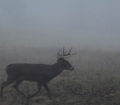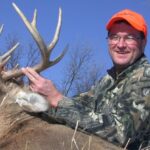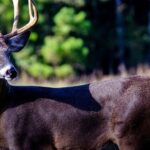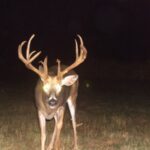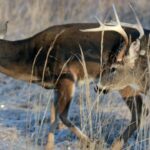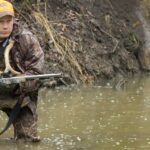John’s Note: To be a more-consistent hunter, you must know everything you can about the animals you hunt, and the other people who are trying to take those same deer. However, during the short span of time that deer season encompasses when the hunter can gather this information, his interest generally is distracted by his desire to take a buck. To gain this knowledge, the very best time of the year to scout is immediately after the season is over. The only disadvantage you’ll have is you won’t be able to harvest the animal after you’ve gained the knowledge required to find him. But what you’ve learned in the post-season will become extremely valuable in all the seasons to come. In my opinion, the single-most-important ingredient to a deer hunter’s continued success is this wealth of knowledge he amasses about the sport in which he participates. One of the best ways to gain that knowledge is by scouting after the season for deer.
Most hunters wait until 2 weeks before deer season to begin their scouting and then attempt to determine where the deer are, and where they can set-up an ambush plan. Very rarely do they know the size of the deer, the sex of the deer or the age of the deer they’re hunting, or what their odds are for bagging a trophy buck. However, the trophy hunter is not hunting deer in general but rather is hunting that one superior buck that has survived a minimum of three seasons and is one of the smartest animals that walks in the woods. Therefore, before the trophy hunter can make his plans for the next season, he first must learn if there is a trophy buck on the property he intends to hunt for the coming year. If there was a trophy buck on this property in the past season, he needs to learn whether or not that deer has survived for yet another year.
 After the season, a trophy buck will begin to leave his hideout he’s been using to dodge hunters all season long. He’ll be easier to find. By careful observation, you may learn the location of his deer-season hideout. Scouting the woods after the season also gives you information about the land’s deer herd, especially if you find dead deer and particularly a dead trophy whitetail. Often when a trophy buck is found dead after the season, hunters assume the animal was wounded during the season and then died because he never was recovered. However, oftentimes big bucks die-off due to natural mortality.
After the season, a trophy buck will begin to leave his hideout he’s been using to dodge hunters all season long. He’ll be easier to find. By careful observation, you may learn the location of his deer-season hideout. Scouting the woods after the season also gives you information about the land’s deer herd, especially if you find dead deer and particularly a dead trophy whitetail. Often when a trophy buck is found dead after the season, hunters assume the animal was wounded during the season and then died because he never was recovered. However, oftentimes big bucks die-off due to natural mortality.
Dr. Billy Hillestad, a longtime wildlife biologist, researcher and consultant, explained that, “I’ve studied older-age-class deer and have learned that often a dominant buck may die after the season because of the stress and battles he’s had to endure during the rut. A dominant buck in a population of older-age-class bucks may have to fight frequently with other bucks to protect his territory and his harem. That dominant buck is much like the bully of the neighborhood. He can beat anyone who comes against him on any day. However, he can’t whip every kid in the neighborhood every day.
 “During the rut, the dominant buck sleeps very little, feeds hardly at all, breeds frequently and fights often. Too, in most areas, the rut occurs when there’s the least amount of food available in the woods. Therefore, a dominant buck is put under maximum stress because of his need to breed and fight, yet he lacks nourishment. Consequently after the rut, his body is so beat-up that sometimes he dies. Since few hunters are in the woods immediately after the rut, most of the time these big deer never are found.”
“During the rut, the dominant buck sleeps very little, feeds hardly at all, breeds frequently and fights often. Too, in most areas, the rut occurs when there’s the least amount of food available in the woods. Therefore, a dominant buck is put under maximum stress because of his need to breed and fight, yet he lacks nourishment. Consequently after the rut, his body is so beat-up that sometimes he dies. Since few hunters are in the woods immediately after the rut, most of the time these big deer never are found.”
Discovering a dead trophy buck in the woods after the season is heartbreaking for the hunter because he realizes he’ll have to move to another region and try to locate another trophy buck to hunt. However, if he goes into the woods after the season, searches for dropped antlers, and discovers a heavy rack that’s been shed, then he can be assured he has a trophy buck in that area to try and hunt the following year. Depending on the numbers and sizes of shed antlers he discovers, he also can get a reasonable indication of the number of bucks still left on the property and the size of the bucks that should be there for the upcoming season. If the sportsman fails to find any evidence of a trophy buck on the particular property he’s scouting, then he may be better off going to other land and searching for antlers in hopes of pinpointing a trophy buck to hunt the next season.
 You’ll learn more deer-hunting information and tips from hunters in John E. Phillips’ Kindle, CreateSpace and Audible books by going to https://johninthewild.com/books/#deer to purchase and download to your Kindle, and/or download a Kindle app for your iPad, SmartPhone or computer. You also can go to Nook Books at www.barnesandnoble.com to buy. Too, you can download free books by going to https://johninthewild.com/free-books.
You’ll learn more deer-hunting information and tips from hunters in John E. Phillips’ Kindle, CreateSpace and Audible books by going to https://johninthewild.com/books/#deer to purchase and download to your Kindle, and/or download a Kindle app for your iPad, SmartPhone or computer. You also can go to Nook Books at www.barnesandnoble.com to buy. Too, you can download free books by going to https://johninthewild.com/free-books.

